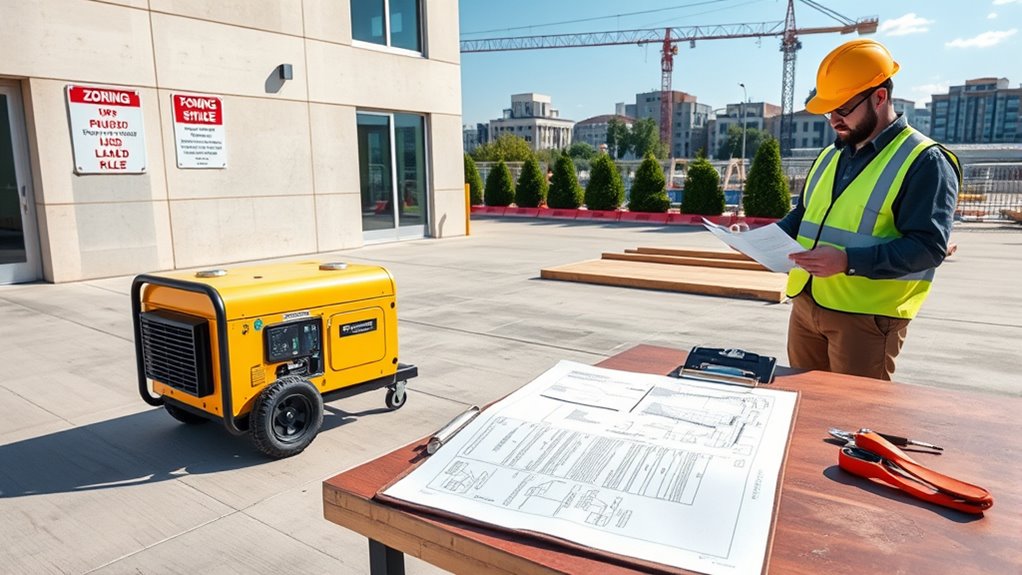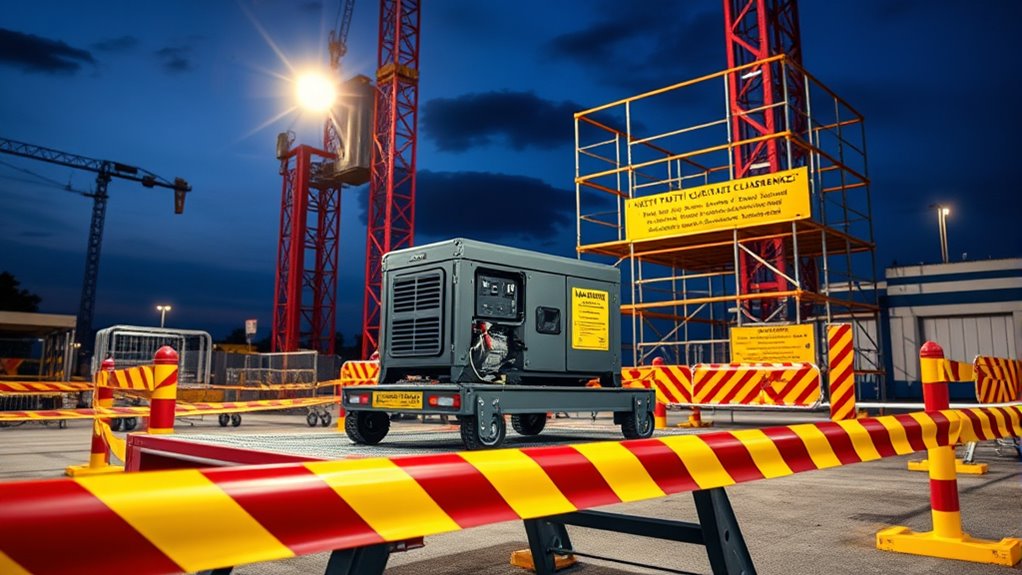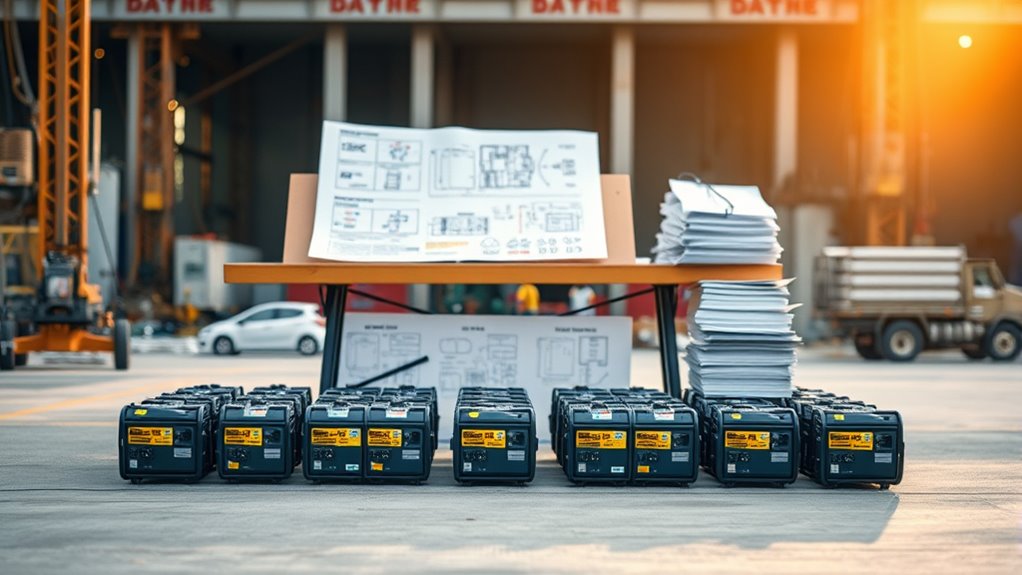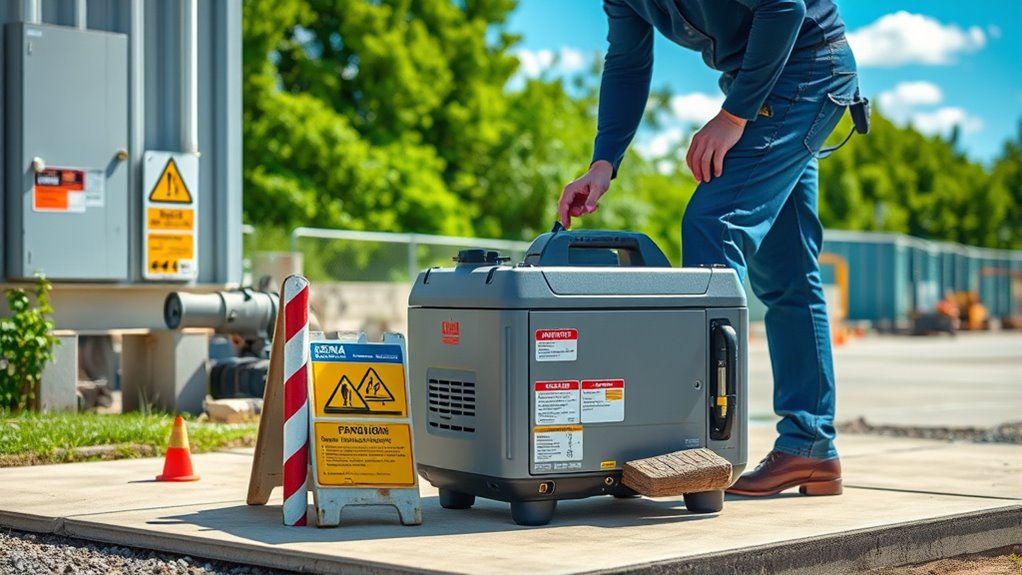To quickly guarantee your generator setup complies, start by checking local zoning laws and building codes, especially regarding noise limits and aesthetics. Maintain safety clearances—20 feet from windows and vents, at least 10 feet from structures, and 3 feet for access. Obtain necessary permits with detailed plans, including noise mitigation measures. Proper placement on a level surface, away from combustibles, and using sound barriers will help. Keep these tips in mind, and you’ll master the essentials in no time.
Key Takeaways
- Check local zoning laws and building codes for setback, noise, and aesthetic requirements before placement.
- Maintain at least 10-15 feet clearance from structures, windows, and occupied areas for safety and ventilation.
- Ensure fuel tanks are stored a minimum of 10 feet from structures and combustibles, following safety guidelines.
- Obtain necessary permits and submit detailed site plans to local authorities to ensure compliance.
- Use noise barriers or enclosures and place on stable, level surfaces to minimize disturbances and ensure stability.
Understanding Local Regulations and Zoning Requirements

Understanding local regulations and zoning requirements is essential before installing a generator, as these rules can vary markedly between jurisdictions. You need to check if there are restrictions on generator aesthetics, such as color or design, to ensure your unit blends with your property. Noise mitigation is another key factor; many areas have limits on sound levels, especially in residential zones. Some neighborhoods require soundproof enclosures or specific placement strategies to reduce noise impact. Failing to comply with these regulations can lead to fines or forced removal. Before proceeding, review local ordinances, building codes, and zoning laws to confirm what’s permitted. Conducting a visual assessment of your property can help identify potential noise or aesthetic issues before installation. Doing so helps you avoid costly mistakes and guarantees your generator installation adheres to all necessary standards.
Key Safety Clearance and Distance Guidelines

Guaranteeing proper safety clearances around your generator is vital to prevent accidents and ensure efficient operation. You should maintain specific distances to reduce fire hazards related to fuel storage and minimize noise impact. For example, keep fuel tanks at least 10 feet away from structures and combustible materials. Noise mitigation is also essential; place the generator at least 15 feet from occupied areas to limit sound disturbance. Use the following guidelines:
| Safety Aspect | Minimum Distance |
|---|---|
| Fuel Storage | 10 feet from structures |
| Noise Mitigation | 15 feet from occupied areas |
| Combustible Materials | 5 feet away |
| Maintenance Access | 3 feet clearance |
Following these key safety clearance and distance guidelines helps protect you and your property. Additionally, ensuring proper ventilation around your generator can help prevent overheating and improve overall safety.
Permitting Process and Documentation Essentials

Before installing a generator, you need to navigate the permitting process and gather the necessary documentation to guarantee compliance with local codes. This includes submitting plans that detail fuel storage methods, ensuring safe storage and handling of fuel to prevent hazards. You’ll also need to demonstrate noise mitigation measures, such as sound barriers or enclosures, to meet local noise ordinances. Obtain permits from your city or county, which may require site plans, equipment specifications, and safety protocols. Keep records of inspections and approvals throughout the process. Proper documentation not only streamlines approval but also ensures your generator installation adheres to safety and environmental standards, avoiding costly delays or violations. Staying organized and proactive makes the permitting process smoother and quicker. Additionally, understanding the angel numbers associated with spiritual guidance can help you feel more confident during the process.
Compliance Tips for Safe and Efficient Generator Placement

To guarantee your generator operates safely and efficiently, it’s crucial to follow key placement guidelines that comply with local codes. Proper placement enhances fuel efficiency and minimizes noise, ensuring safety and comfort. Keep the generator at least 18 inches from structures to prevent carbon monoxide buildup and ensure proper ventilation. Position it on a level, stable surface to avoid vibrations that reduce efficiency. Use noise barriers or enclosures to cut down sound levels, promoting noise reduction for neighbors and your peace of mind. Additionally, understanding the spiritual significance of certain environmental symbols can help you create a harmonious placement that aligns with your personal energy. Maintain adequate clearance from windows and vents. Ensure proper ventilation to maximize fuel efficiency. Install soundproof barriers or enclosures for noise reduction.
Common Pitfalls to Avoid and Resources for Assistance

One common mistake is overlooking local codes and regulations, which can lead to costly fines or safety hazards. Proper generator maintenance is essential to ensure reliable operation and compliance. Failing to follow storage guidelines for fuel can cause fire risks or environmental issues. Avoid placing fuel tanks near ignition sources or in unapproved areas. Additionally, neglecting to regularly inspect and maintain your generator can result in breakdowns during emergencies. To prevent these pitfalls, consult local building codes and fire safety standards. Resources like local permitting offices, certified contractors, and industry associations can provide guidance. Always stay updated on changing regulations and best practices for fuel storage and maintenance. Understanding generator placement rules and the importance of compliance helps you avoid costly mistakes and keeps your generator compliant and safe.
Frequently Asked Questions
How Often Do Local Regulations for Generator Placement Change?
Local regulations for generator placement can change unpredictably, often due to regulatory updates and zoning amendments. You should stay informed regularly because these updates may occur annually or less frequently, depending on your area. Monitoring local government websites or subscribing to official newsletters helps you keep track of changes. By doing so, you guarantee your generator installation remains compliant with current rules, avoiding potential fines or safety issues.
Are There Specific Noise Level Restrictions for Generators in Residential Areas?
Yes, there are specific noise restrictions for generators in residential areas. You need to adhere to residential noise limits, which typically specify maximum decibel levels during certain hours, often quieter at night. These noise restrictions aim to minimize disruptions for neighbors. Always check local ordinances to guarantee your generator stays within permitted noise levels, and consider soundproofing or placement strategies to reduce noise emissions and stay compliant.
What Are the Consequences of Non-Compliance With Placement Codes?
Ignoring placement codes is like opening Pandora’s box—you risk legal penalties and safety hazards. Non-compliance can lead to hefty fines, permit revocations, or even costly legal action. Plus, improperly placed generators may cause carbon monoxide poisoning, fire hazards, or noise issues, endangering your property and neighbors. Staying within the rules guarantees you avoid these risks, protecting everyone and keeping your project on track.
Can I Install a Generator Myself Without Professional Help?
You can attempt a DIY installation, but it’s not recommended due to safety considerations. Installing a generator yourself might save money initially, but improper setup can lead to electrical hazards, code violations, or damage. You should thoroughly understand local codes and safety protocols before proceeding. For best results and safety, it’s wise to hire a professional who’s experienced with generator installation, ensuring everything’s compliant and safely connected.
Are There Financial Incentives or Rebates for Compliant Generator Installations?
You might be eligible for financial incentives or rebate programs if you install a compliant generator. Many utility companies and local governments offer these perks to encourage safe, efficient installations. Don’t assume you won’t qualify—check your area’s programs, as rebates can substantially offset installation costs. Taking advantage of these incentives not only saves you money but also ensures your generator meets all safety and code requirements.
Conclusion
By mastering these quick rules, you’re building a sturdy bridge between safety and efficiency, guiding your generator placement with confidence. Think of it as charting a clear path through a dense forest—avoiding hidden pitfalls and revealing smooth passage. With each step, you’re laying down the foundation for a secure, compliant setup that powers your home reliably. Embrace these guidelines as your trusty compass, ensuring your generator finds its perfect, safe home amidst the rules.









